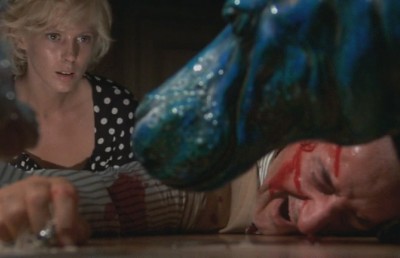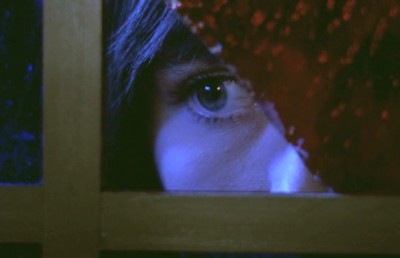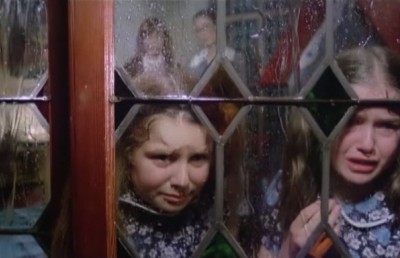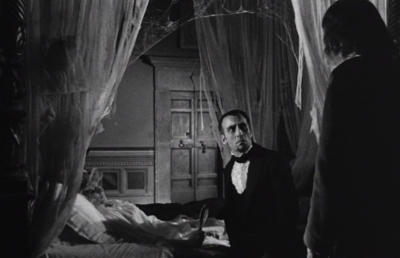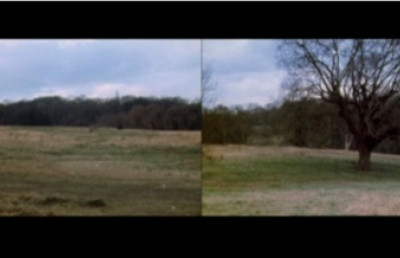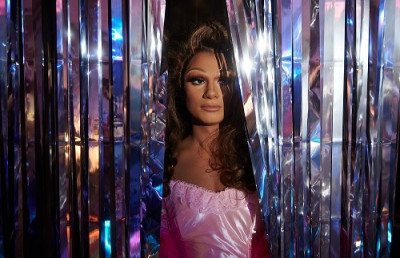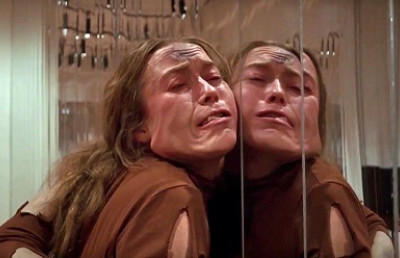Rediscovering Brunello Rondi
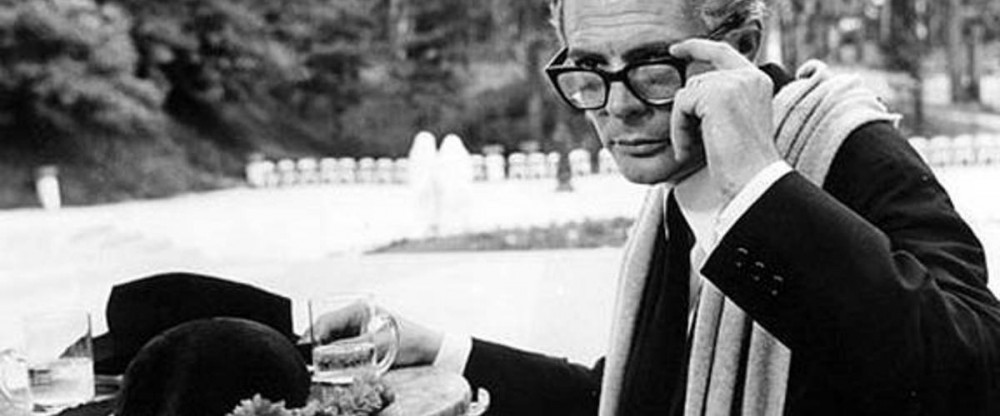
In 1958, the illustrious Cesare Zavattini wrote about Brunello Rondi that “he is both humble and presumptuous, just like his thoughts […]; I see him as one of those who know better the times we’re living in. He is so eager to live in these times that he’s almost moving.” Zavattini hoped that the young intellectual would soon make his feature debut, in order to describe those times “with the same strength and poetry that one would use to describe his first love.” [1] Fifteen years later another nameless critic, reviewing Rondi’s “latest erotic potboiler” Tecnica di un amore, stated that “the director’s expressive deficiency is such that, even though here and there a few tormented intentions come to the surface, everything gets lost in confused banality, coarse clichés and indigestible amounts of nudity and sexual intercourses.” [2] What had happened?
Born in 1924, Brunello Rondi was – as his elderly brother Gian Luigi, one of Italy’s most renown film critics, used to say – a Renassaince man. He was a poet, a philosopher, a musicologist, a film critic and a well-respected playwriter: his plays Il viaggio, La stanza degli ospiti, Gli amanti (the latter brought to screen in 1968 by Vittorio De Sica and starring Faye Dunaway and Marcello Mastroianni) were brought to stage by Italy’s most prestigious companies and were favourably received by critics. Rondi’s first steps in the cinema dated late ‘40s, when he co-wrote the war drama Ultimo amore (1947, d.: Luigi Chiarini) starring Clara Calamai and Andrea Checchi. He then worked with Roberto Rossellini on Francesco giullare di Dio (1950): Rossellini’s brilliant take on Saint Francis of Assisi’s life – shot with a non-professional cast, most of them real Franciscan friars, including leading man fra’ Nazario Gerardi who portrayed Francis – was the first of three films Rossellini and Rondi worked on together, the others being the outstanding Europa ’51 (1952), starring Ingrid Bergman, and the war drama Era notte a Roma (1960).
Francesco??’s other scriptwriter was Federico Fellini, with whom Rondi was to begin a fruitful and lasting working relationship: starting with ??La strada (1954), Rondi was initially credited as “artistic advisor,” a credit which he maintained also on Il bidone (1955), Le notti di Cabiria (1957), La dolce vita (1960) and 8 1/2 (1963). On La dolce vita, Rondi was also co-scriptwriter, together with Ennio Flaiano and Tullio Pinelli. According to Fellini himself, several of the film’s most brilliant sequences germinated from Rondi’s ideas: the decadent party in the house of a Roman prince, the “miracle” scene and the final orgy with its bitter aftermath on the beach at dawn. Rondi co-wrote Fellini’s following films, Le tentazioni del dottor Antonio (in Boccaccio 70, 1962), 8 1/2 (Fellini stated that Rondi enthusiastically embraced the project when it was only a just vague idea, whereas Pinelli and Flaiano were quite perplexed [3]), Giulietta degli spiriti (1965), the sadly never made Il viaggio di G. Mastorna (1965-67), Fellini – Satyricon (1969, on which Rondi admitted that his contribution was only nominal [4]), Prova d’orchestra (1978), La città delle donne (1980). [5]
By the end of the Fifties, Rondi was a well-known, respected, eclectic intellectual. He contributed to film magazines, worked with prestigious directors (including Alessandro Blasetti, on the comic anthology Altri tempi, 1952), taught acting at Rome’s Centro Sperimentale di Cinematografia and even directed a handful of short documentaries. The time for his feature debut as a director came in 1962, when he was 38. Producer Moris Ergas had bought the rights to Pier Paolo Pasolini’s novel “Una vita violenta” (A Violent Life) and hired Rondi to co-direct the film together with Paolo Heusch. Una vita violenta (1962) was rather well received by critics, who pointed out its formal qualities and impressive mise-en-scène, even though comparisons with Pasolini’s stunning film debut Accattone (1961) were unfavourable. Both films starred Franco Citti, a non-actor who would later become one of Italian cinema’s most recognizable faces, and the plots are somewhat similar in following a young subproletarian’s journey towards social conscience, which leads to his death. His brother Sergio, who would become a director himself, giving Italian cinema a number of extraordinary, weirdly poetic films (including Ostia, 1970; Storie scellerate, 1973; Casotto, 1977) was the dialogue consultant.
Una vita violenta’s best moments are to be found in its first half hour, which follows the excesses of a bunch of young lower-class neofascist delinquents. After breaking into a theater where Rossellini’s Il Generale Della Rovere (another Moris Ergas production) is being projected, Tommaso (Citti) and his friends assault young couples, rob a gas store attendant, and rape a French girl. At dawn, adrenaline and rage leave way to a deeply melancholic resignation. The rape scene was an addition to Pasolini’s novel, and it’s perhaps a hint at what Rondi would do next. “Are you going to communion, sweetheart?” one of the thugs comments sarcastically. To Rondi scholar Alberto Pezzotta “the French speaking victim who is wearing a white veil […] looks like a ghost, a Fellini-esque apparition, as the film abandons all existing models (the films of Franco Rossi and Mauro Bolognini with screenplays written by Pasolini) and goes beyond realism to offer an intricately interwoven parable set in a least three different temporal dimensions: the memory dimension (the centre of Rome taken over by thugs) the modern dimension (the futuristic building in front of which the violence takes place) and the dimension of the underprivileged Pasolini-esque characters who are excluded from progress.” [6]
If Una vita violenta was still a sort of a test, 1963 marked Rondi’s proper “solo” debut as a director. He conceived a story set in contemporary rural Southern Italy, about a young woman living in a remote mountain village whose sexual unhibition has her fellow countrymen believe she’s been possessed by the devil. If the title Il demonio (The Devil) might let you think that this is typical ‘60s Italian horror fare, well it’s not. As Raymond Durgnat puts it, the plot goes as follows: Purificazione (a name which in Italian means “purification”) “is beset by infernal voices, curses her lover when he marries another girl, is raped by a shepherd, exorcized by a priest (to no effect), and finally, seducing her lover, falls asleep in his arms, when, his wrath reborn, he carves a cross on her breast and murders her.” [7] Rondi’s aim was the portrayal of a “telluric” character, and the deep implications of the subconscious and irrational beliefs on personality. Such a character is Purificazione.
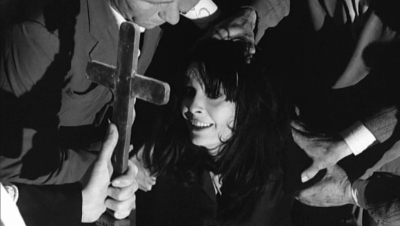
Il demonio starred a stunningly beautiful Israelian actress, Daliah Lavi, whose dark eyes and animal stare made an indelible impression. In that very same year, Lavi played the lead in Mario Bava’s La frusta e il corpo (Whip and the Body), and later moved to Hollywood with not much luck. The only other professional in the cast was Frank Wolff as Purif’s object of desire.
Shot during the Second Vatican Council, in a period where the Church was slowly undergoing huge transformations, and released a few months after the death of Pope John XXIII, Il demonio was a grim view of a country still plagued with superstition, which clearly predated and inspired Fulci’s Don’t Torture a Duckling: if Purif is a model for Florinda Bolkan’s “Maciara,” the local witch doctor Zi’ Giuseppe, who should cure Purif but abuses her instead predates that of Georges Wilson in Fulci’s film. Rondi also clearly drew on Italian literary tradition: Purif’s character brings to mind Giovanni Verga’s novel La lupa (brought to the screen by Alberto Lattuada in 1953 and by Gabriele Lavia in 1996). The director stated that he did not care for a study on madness à-la The Snake Pit; rather, Purif’s relentless spiritual anxiety is closer to the sweet delirium that pervades the character of Johannes in Dreyer’s Ordet. Rondi later stated that the possessed Purif is an anticipation of Italian cinema’s most famous rebel, Lou Castel in Marco Bellocchio’s I pugni in tasca. Both display their rebellion through their body and irrational explosions (in Bellocchio’s film Castel character is an epileptic) which society vainly tries to stop and cut off, in Purif’s case through a ritual exorcism. Purif’s dark force is a primordial cry against the whole world, starting from her own family.
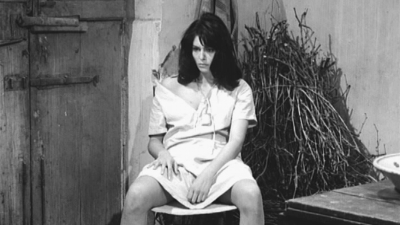
Daliah Lavi
What the director cared for was also an in-depth study of Southern Italy’s culture and traditions, as Rondi collaborated with renown ethnologist Ernesto De Martino. Carlo Bellero’s outstanding b/w scope cinematography vividly brings to the screen a barren land of windy high plains, small villages clinging on mountain sides and skeleton-like olive trees, yet Rondi was adamant in asking Bellero “a cinematography which would resolutely prune realistic atmosphere and the smallest hint of folklore, the light-and-shadow contrasts, the heat, the usually sleepy southern climate or the abuse of whites” [8] in order to create a “different” Southern Italy, far from the usual stereotypes seen in Italian cinema. Similarly, Piero Piccioni’s electronic score, which rejects melody and usual film score trappings, hints at a deeper vibrating quality beyond everyday life.
The many semi-documentaristic scenes display the mixture of Christian and Pagan rites that the villagers perform, showing how Catholic religion has changed where it’s been contaminated by local costumes and beliefs. At a wedding, the wife’s parents check if there are any knots or nodes outside the church’s door; the conjugal bed for the wedding night is covered with grape and salt in a complex rite which should make the devil stay away; later, a procession has the penitents walk in the village’s main square carrying heavy rocks which symbolize their own sins, which they will then confess in front of all the other villagers. They exhibit images and icons of saints which look both grotesque and frightening.
Superstition and faith become interchangeable, so that the exorcism performed in church by a priest is no different from other absurd Pagan rituals. In this incredible scene, Purificazione even performs a so-called “hystero-epileptic arch” which recalls Linda Blair’s infamous “spider walk” in the restored version of Friedkin’s The Exorcist (1973). Censors didn’t like Rondi’s quote of Brecht’s Life of Galileo in the end, which was removed after the film’s first showings. [9] It was one of several cuts that had to be made: Rondi’s following films would often have such censorship troubles.
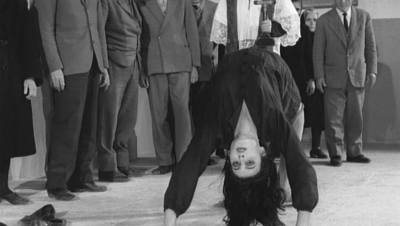
An uncannily Exorcist-like moment in Il Demonia
When Il demonio was shown at the Venice festival, most Italian critics destroyed the film. One accused Rondi (himself a Catholic) to have made an anti-Catholic film, while the highly ideologized Cinema Nuovo was so aggressive that Rondi wrote not one but two raging letters to the magazine’s editor, Guido Aristarco. One dissenting voice was that of Edoardo Bruno, who favourably compared Rondi’s vision to that of Buñuel, calling Il demonio one of Italy’s first examples of cinematic surrealism: “for the first time, the great surrealist themes come to the fore in Italian cinema: mad love, violent tirades against the dullest aspects of society, the glossy close search of erotic elements in religion, both pagan and Catholic.” [10]
Foreign critics, on the other hand, understood Rondi’s approach to eroticism, describing it as a force of traumatising power. In his volume Sexual Alienation in the Cinema, Raymond Durgnat wrote: “One can imagine how English or American horror specialists might have handled such a theme. […] For Rondi, Purif’s superstition is simply a climax form of the village’s feudalism, and psychological explanations are eschewed (apart from the self-evident postulation that her particularly passionate temperament has been subjected to special stresses by the ethos indicated by her Christian name […]). Episodes which might well have become melodramatic or Manichean denunciations of intolerance become more intricate transactions. […] So ambivalent is human nature that a hostile society has every opportunity to turn the individual against himself, and make each deviant his own executioner. The story interweaves three fetish systems: 1) the village’s mixture of superstition and prudent worldliness […]; 2) the church’s blend of exorcism (or witchcraft-cut-witchcraft), of erotic bizarrerie (the nuns as brides of Christ), and 3) Purif’s internal conflicts of love and hate. Each system has its own insanity.” [11]
This emphasis on eroticism, and the director’s ability to portray tormented and suffering female characters, would mark Rondi’s following output. “I’ve always been faithful – even in unpopular ways – to the issue of male and especially female neurosis” he stated. “In my films there are always female characters who communicate their neurosis through eroticism. I’ve often been interested in a destructive love exuberance, which furiously devastates whatever’s around. Italian critics have often mistaken my attention to female eroticism for exploitation, whereas it was all about neurosis.” [12]
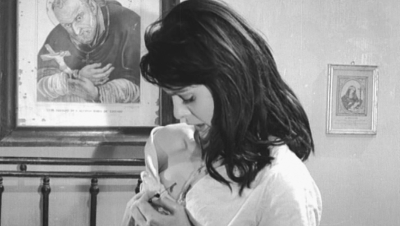
Il demonio??’s lack of box office success seemed to halt Rondi’s career for a while, though, and his next filmed project would suffer a sad fate. Shot presumably in late 1965 or early 1966, ??Più tardi Claire, più tardi… was a peculiar murder mystery set in 1910, with a composite cast including Hollywood has-been Gary Merrill, German beauty Elga Andersen, future Franco acolytes Michel Lemoine and Janine Reynaud and respected theatre actresses such as Adriana Asti and Rossella Falk: Claire (Andersen) the young wife of elderly English judge George Dennison (Merrill) is brutally killed in Dennison’s Italian country villa, and her little son suffers a similar tragic fate. One year later George returns to Italy with a new wife, Ann, who’s a dead ringer for Claire, much to his family’s disgust. It turns out that Dennison has hired the woman (Andersen again) to help him unmask the murderer: the woman’s presence brings to surface the greed and mutual hatred among Dennison’s relatives.
Family as a vipers’ nest would be a recurrent theme in the director’s work; similarly, Rondi would often set his following films in secluded spaces – a villa, an isle, an asylum, a prison – and juxtapose a single character, usually a woman, with a hostile environment or institution. If Purif was defeated by superstition, Ann is a victim of the “status quo,” just as is the disturbed “wild girl” (Adriana Asti) who lives by herself in the woods near the villa. Both are rejected by a self-sufficient microcosm based on hypocrisy and convenience. There is an extraordinary sequence near the film’s beginning where Claire’s little child is playing the piano at a party, surrounded by an indifferent, bored audience: the guests are too busy tattling behind each other’s backs to pay attention to the boy, who’s obviously having quite a hard time playing a difficult Bach piece. It’s a moment that perfectly captures the film’s theme, and shows how Rondi was not just an intelligent scriptwriter, but also quite a capable director.
The plot clearly shows its Hitchcokian influences, but Rondi also hints at pure Gothic in several atmospheric sequences, while character development is definitely closer to art films of the period than genre ones, and the twist ending is surprisingly grim and pessimistic. Rondi had conceived an even more morbid resolution, which dealt with sexual neurosis, voyeurism and scopophiliac tendencies. It was included in a later version of the screenplay which featured a couple of “addictional scenes.” [13] These, which were probably never filmed, displayed Rondi’s idea to make the film something more than a simple whodunit. The other unfilmed scene was an extraordinarily daring Buñuelian dream sequence where Dennison finds himself in the middle of an orgy in the woods where all his family and friends are involved, while Lemoine’s character (a music teacher) directs the couplings just like a conductor. Had these been included, the final result would have been a delirious study on madness and a groundbreaking work.
Shot in an exquisite black and white and featuring a refined score by Giovanni Fusco (with Severino Gazzelloni’s soloist flute in evidence), Più tardi Claire, più tardi… is nonetheless an impressive work, even though the lack of editing credits and several awkward passages (including the sudden presence/absence of first-billed Merrill) may imply serious production problems. The film was shelved and stayed unreleased for at least a couple of years: it was finally picked up for marginal distribution in 1968, and soon sank without a trace.
In the meantime Rondi was undergoing a deeply creative period. His unreleased script dated 1966, The Public-Relations-Man, is a sort of update on La dolce vita, and at the same time a grim comedy in the vein of Pietro Germi’s masterful Signore & Signori (1966). Possibly written for Ugo Tognazzi – with whom Rondi had acted in a one-time performance before the camera, in Luciano Salce’s bitter comedy Le ore dell’amore (1963) – it’s the story of a p.r. agent who puts to best use his ability to persuade people, becoming a mastermind of the chaotic Rome jet-set, until he finally undergoes a crisi of conscience. In the script, Rondi even described the film as “La Dolce Vita ‘66”: it was obviously a heartfelt, ambitious project, and it’s a pity it was never filmed. It’s also a very pessimistic and disillusioned work, which shows the frustration of living in a world where “appearing” is much more important than “being”: but if Rondi the philosopher despised such a world, Rondi the director had to accept more and more compromises in the years to come.
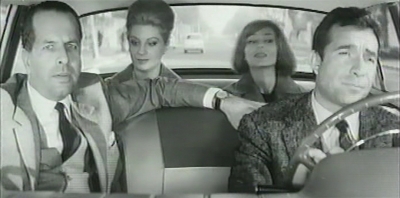
Rondi (left) in acting role, with star Ugo Tognazzi (right) in Le ore dell’amore
Rondi’s official third film (actually his fourth, as we have seen) was Domani non siamo più qui (Tomorrow We Will Not Be Here, 1967), a b/w drama set in the Amalfi coast and starring Ingrid Thulin and Robert Hoffmann. Thulin’s choice showed Rondi’s intentions to shoot a psychological drama in the vein of Bergman’s films (in 1963 he wrote a passionate essay on Tystnaden??/ ??The Silence), while another obvious influence were Antonioni’s films on “incommunicability”. Gioia (Thulin), an American woman who’s still shocked by the death of her little daughter, arrives in Italy at her brother’s villa. Soon her anguish and pain turn into an aggressive sexual behaviour, as she seduces the local doctor (Luigi Vannucchi) and a young philosophy student, Dionigi (Hoffmann).
Even though the fluvial dialogues have badly aged, Rondi’s portrayal of his protagonist’s neurosis is precise, while the director’s approach to eroticism is much more thoughtful and problematic than in many films of the period. Curiously, Rondi radically changed the ending: the original script culminated with Dionigi stabbing Gioia in a fit of rage and fleeing the villa. The caretaker then closes the villa for winter season without noticing Gioia’s body. It was a grim and dark ending that perhaps would have made the film more palatable for younger film buffs and critics who in the 1990s started rediscovering Rondi’s work, somehow misleadingly labelling films like Più tardi Claire, più tardi… and Le tue mani sul mio corpo as (admittedly sui generis) gialli. The filmed ending has Dionigi leaving Gioia alone but very much alive in the villa, and the woman seems at least in peace with her own mind: the title refers to Gioia finally coming to terms with the transient nature of human life.
Once again, formally Domani non siamo più qui was a beautiful work, which nonetheless failed to make an impression at the box office. While still editing the film, Rondi announced another ambitious project: Mille e non più Mille, a story set in the year 1000 B.C. dealing with fears of the Apocalypse, love, power and death in the violent Middle Ages. Orson Welles would play the role of a cruel one-eyed Count, loosely based on a historical character, who falls for a young peasant girl and persecutes her and her husband. “I intend to paint a deeply violent medieval time, as the Japanese have done in The Seven Samurai. And I believe, moreover, that today, while the western is fading, the Middle Ages can offer a new thread, through the epic events that will highlight the raw and violent contrasts.” [14] Rondi was not wrong: in a few years the Middle Ages would offer material for a popular new thread… only not in the epic way he imagined, as the so-called Decamerotics would show.
Two more projects came to a dead end. The first was Honeymoon, a thriller written with Luciano Martino: in an article dated October 1967 [15] Rondi announced that he was about to start shooting in Geneva and Cote d’Azur with Carroll Baker and Jean Sorel, but one look at plot and characters’ names reveals that this is the same film that eventually came out next March as Il dolce corpo di Deborah (The Sweet Body of Deborah, 1968, d. Romolo Guerrieri). Even though the article seems to imply that Rondi co-wrote the script, Deborah??’s screenwriter Ernesto Gastaldi states that the director was not involved at all in the project, though, so this remains some sort of a mystery: did Martino consider him as a director before hiring Guerrieri? However, later on Rondi would direct another film for Martino, based on a story by the producer. It was a compromise of some sort, starting with the title: initially Rondi chose ??Questo amore così tenero, così violento, così fragile… così disperato (This Love So Tender, So Violent, So Fragile… So Hopeless, a paraphrase of the opening verses in Jacques Prévert’s poem Cet amour), which became Shocking and eventually the decidedly less poetic Le tue mani sul mio corpo (Your Hands On My Body) (1970).
The story follows a disturbed rich young man, Andrea (Lino Capolicchio), haunted by a childhood trauma (he saw his mother drown in the sea), who acts as an irresponsible spoiled brat and repeatedly provokes his beautiful young stepmother Mireille (Erna Schurer). The love for an American girl (Colette Descombes) seems to cure him, but after making love Andrea takes her to the beach and stabs her, in an unexpected twist which recalls ??Domani non siamo più qui??’s original ending.
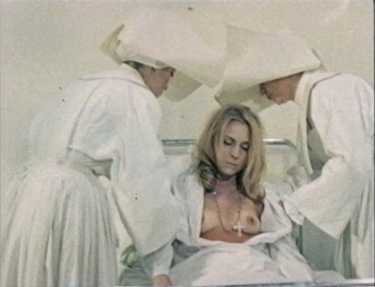
Rondi’s depiction of the moral cancer devouring bourgeois family is displayed in the estranged relationship between Mireille, Andrea and his father (José Quaglio). Capolicchio’s character can be seen as an evolution of Lou Castel’s Alessandro in Bellocchio’s I pugni in tasca (1965) just as Purif was his anticipation, and is also quite similar to the one played by Capolicchio in Roberto Faenza’s 1968 feature debut Escalation. If Andrea’s regressive impulses and his desire to become a child again symbolize the immaturity of a whole generation, the latter – a wealthy publisher specialized in those glossy magazines exposing naked women on the cover that perfectly represent the way sexual enlightenment has been incorporated, neutralized and put to commercial use by capitalism – says: “We want to save from oblivion and bring to the masses everything that is visible and intelligible in art… and those masses are following us.”
To a Catholic like Rondi, the point was not to focus on the evils of Capital but on the loss of moral and cultural values that accompanied the dissolution of Italian culture – a danger that was becoming evident to intellectuals like Pasolini and Cavallone. The discourse on the mercification of the female body results in a surreal scene which predates Cavallone’s Spell where Andrea compares a naked female body to that of a bovine, playing with a life-size female figure who’s jigsaw body parts are likened to various beef cuts.
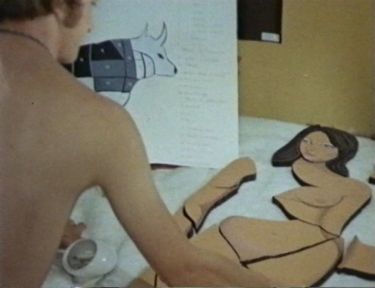
Once again the director tells the story of neurosis, this time from a young male’s point of view: Andrea’s visions include oneiric flashbacks of his youth – including a terrific primal vision of sex and death, as the young boy watches his dead mother having her clothes taken off by two nuns on her death bed, an image worthy of Buñuel – while his sexual obsession has him filming the unaware Carol as she’s making love with her boyfriend.
Unfortunately Rondi failed to shape a satisfying third act, and the film (promoted as a lurid erotic thriller) actually stands uneasily between would-be art film and genre. Yet Le tue mani sul mio corpo is a key work to understand Rondi’s subsequent career path. Let’s consider the period between 1967 and 1970, the year the film came out. Rondi was particularly active, with many projects as a director which didn’t materialize, and just as many scripts written for other directors: Mauro Bolognini’s Arabella (1967), a period comedy starring Virna Lisi, James Fox and Terry-Thomas, was from a Rondi-penned story which had been around for a while; De Sica’s Amanti brought to screen Rondi’s own successful theatrical play; he also co-wrote Le sorelle (1969, d.: Roberto Malenotti), a morbid drama starring Susan Strasberg and Nathalie Delon as siblings tied by a subterranean incestuous relationship; last but not least, Pasquale Festa Campanile’s astonishing Scacco alla regina (1969, written by Rondi and Fellini’s other acolyte Tullio Pinelli from a novel by Renato Ghiotto) was a wild, psychedelic wet dream about a rich girl (Haydée Politoff) with masochistic fantasies who becomes the slave of a decadent, tyrannical actress (Rosanna Schiaffino) who takes great pleasure in humiliating her employees.
The latter two are perfect examples of the growing role of eroticism in Italian cinema after 1968. Le sorelle, with its luscious lensing, soft-focus flashbacks and hinted morbidity, is a typical art film wannabe, while Scacco alla regina features copious amounts of nudity in a plot revolving around a sexual obsession, in a world where everything – including people – can be bought and reduced to a thing (a theme dear to philosophers such as Adorno and Marcuse, and often alluded to in Italian movies of the period: think of Corrado Farina’s vampire allegory …Hanno cambiato faccia, 1971). [16]
With his following works, Rondi would fully embrace erotic cinema, partly out of necessity, partly because it suited his own interests as a key to explore the changing face of Italian society: his later films would delve more and more with sexual behaviour, in the meantime exploring the decadence of feelings, the “reification” of the female body, and the connection between economical and sexual power. Inevitably, critics often focused on the mere erotic element, accusing Rondi of “selling out” and placing irony on the uneasy way his intellectual pretensions were spiced with nudity and softcore sex. Compromises were inevitable, from the smaller budgets to the lurid and allusive titles. Yet Rondi’s output in the 1970s, even though discontinuous, was nevertheless quite interesting and provocative, fluctuating in a no man’s land between genre and commitment, but ultimately hard to swallow for both genre fans (who, despite the copious amounts of nudity and morbidity, were treated with depressing storylines, ponderous dialogue, slow pacing) and art film buffs (for the exact opposite reasons).
Originally just titled Valeria or V. come Valeria (V. for Valeria), the script of Rondi’s sixth film germinated a couple of years before it was filmed. Rondi told the press that the idea came to him from the true story of an acquaintance, an upper-class woman who had been hospitalized by her husband in a mental institution, as well as from a visit he and Fellini paid to an asylum for an undeveloped project based on Mario Tobino’s novel Le libere donne di Magliano. Rondi also drew on the growing debate around the condition of the mentally ill, and the rise of Anti-psychiatry, with contributions by the likes of Michel Foucault, R. D. Laing, Thomas Szasz, and Franco Basaglia. “Valeria’s a tormented personality, probably richer and more gifted than other creatures. She should be helped to express herself and instead is, on the contrary, oppressed by society,” Rondi said. “Hence the distortions and deviations of Valeria, a woman who, in practice, is being prevented from healing, hence her boundless solitude and her slide into madness, in that realm where reality surpasses the dream.” [17]
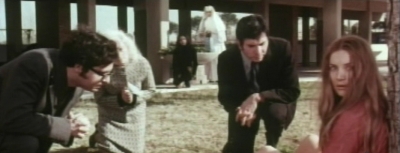
For the role of Valeria, a rich woman who is neglected by her husband, and whose unhappiness and loneliness allow her neurosis to develop into a mental disorder, Rondi chose blonde goddess Barbara Bouchet, who gave quite a convincing performance in a role different from her usual ones. The husband, a successful electronic composer, was played by Pier Paolo Capponi: Rondi’s interest as a musicologist shows in the director’s juxtaposition of a cold, abstract electronic score for Valeria’s conjugal life to serene classical pieces in the asylum scenes, where they act as a contrast to the staff’s inhuman methods. The film came out in 1972 as Valeria dentro e fuori (Valeria inside outside): the crude double-entendre stressed the erotic element, even though Rondi seemingly brings back her illness (as well as that of other inmates as well) to a sexual neusoris, allowing for ample nude scenes, the depiction of Valeria’s case is nonetheless powerful and rather an uncompromising “portrait of a woman’s condition in a capitalistic society,” as one critic wrote.
“I don’t like pale-skinned women,” her contemptuous husband David says, betraying his fetishistic attention to appearance, which is mirrored by the cold, detached house he and Valeria live in: with its black painted walls and abstract patterns, it’s already a cell in disguise. To David, Valeria is just a thing: first she’s a trophy to be shown at parties and a sexual object, then a source of inspiration for his music – not a Muse, beware: as he witnesses Valeria being painfully examined by the doctors (who perform a painful lumbar puncture on her), David feverishly composes music, turning Valeria’s screams of pain into notes. His vision is methodical, mathematical and cold, he can only draw inspiration from physical phenomenons but cannot understand his companion’s soul. David’s sadistic, fascinated stare as he watches the lunatics in the final scene hints that he’s possibly as insane as them, yet he’s perfectly integrated in a soulless world, cold and suffocating as a gigantic padded cell: which is exactly what Rondi meant to depict.
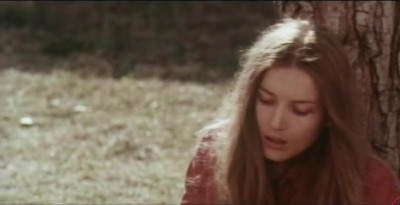
Barbara Bouchet as the ‘alienated’ Valeria
Compromises meant concessions to popular genres. A few years earlier Rondi had predicted a renewed interest in the Middle Ages: that’s exactly what happened after the succès de scandale of Pasolini’s Decameron (1971). Dozens of sex comedies set in the Middle Ages, loosely based on Italian 1300 literature as a pretext to have beautiful women take off their clothes, with vulgar and humorous titles and stories about cuckold husbands, horny friars and sex-hungry wives: that was the so-called Decamerotic genre. That’s where Rondi ended up with his next film… more or less. Soon after Valeria??’s release, he announced a new project, ??Maestro d’amore (Master of Love, a title that paid homage to Bergman’s Love Lessons). “The film cannot be inserted into the rampant Boccaccio-inspired genre. To me, this sordid phenomenon we are witnessing is nothing but the exact mirror of a neo-fascist time, with its new explosion of virility and its coarse, clumsy and indifferent humor,” [18] he stated. For one, the setting was not in the Middle Ages but in the more refined Renaissance; co-scriptwriter Roberto Leoni, who wrote the film with Rondi and Gianfranco Bucceri, [19] adds: “We had the idea to set the film in this sort of Renaissance Eden which is not just erotic, but also adventurous and fable-like, in which there was still the gallantry, the joke, the game still existed. Then there was the advent of Decamerotics and the film was wrongly regarded as one. But it’s not.” [20] Yet, when the film was released, Rondi’s original title was dropped in favour of Racconti proibiti… di niente vestiti (Forbidden tales… with no clothes on), a typically gross title which made it look like it was, indeed, a typical Decamerotic flick.
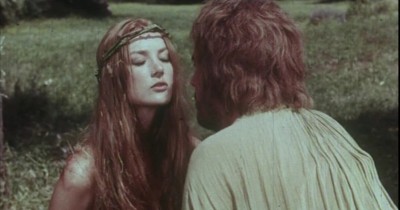
Barbara Bouchet in Racconti proibiti… di niente vestiti
A mature womanizer, Lorenzo (Rossano Brazzi) bets with a priest that he will seduce the God-fearing noblewoman Lucrezia (Barbara Bouchet): he’s accompanied on his journey to Lucrezia’s castle by a young unexperienced man, Uccio (Ben Ekland, Britt’s brother) to whom he’ll teach the art of seduction. The film illustrates a handful of stories during Lorenzo and Uccio’s journey: a couple of young peasants (Janet Agren and Norberto Botti) are summoned to the castle of a Duke for the nobleman to exercise his jus primae noctis; a friar (Mario Carotenuto) performs a “miracle” by getting a woman (Paola Corazzi) pregnant in front of her unsuspecting sterile husband (Leopoldo Trieste); a magician (Tina Aumont) takes revenge on her unfaithful lover (Enzo Cerusico); a man goes to collect a debt and is seduced by his debtor’s wife: the other man (Michael Forest) catches them in the act and sodomizes the creditor for revenge. As expected, Lorenzo wins Lucrezia’s resistence (and it turns out that the woman is an avid sadomasochist) and Uccio learns his lesson well, even surpassing his teacher. Lorenzo, suddenly feeling old and tired, leaves. In the final scene, he meets Death as a beautiful naked woman (Monica Strebel, seen in Fernando di Leo’s Slaughter Hotel) and joyously runs away with her in the fields. It’s a beautiful ending, by far the best thing in the film: interestingly, it didn’t appear in the original script, and is probably Rondi’s homage to Bergman’s ??The Seventh Seal??… even though it’s unlikely viewers at the time noticed.
Once again, Rondi focused the equation between sex and power, and his view on religion – in a world dominated by a corrupt, debauched Church – is vitriolic. The “miracle” scene, with peasants chanting in joy while the friar has sex with the woman in front of them all, brings to mind the miracle scene in La dolce vita, where a crowd stood in awe waiting for the Virgin Mary to appear. Besides, Barbara Bouchet’s character has a few scenes which border on the blasphemous: in one she appears to be performing a fellatio on a young man in the pose of the crucified Christ while she’s actually washing his feet. Similarly to Vanessa Redgrave in The Devils, Lucrezia finds sexual gratification through pain and self-humiliation: even though Rondi treats it in a humorous way, the scene where Lucrezia is whipped by Brazzi until her back bleeds and she eventually reaches an orgasm, is unsettling and unpleasant (Bouchet even wears a crown of thorns). Buñuel would have loved it.
Rondi’s eighth film, Tecnica di un amore (1973), co-written by Piero Regnoli and produced by Carlo Maietto and Playmen editor Adelina Tattilo, was a little seen erotic drama which somehow harked back to the director’s work as a playwriter. Set in the beautiful island of Ponza, it featured five main characters and an almost theatrical structure, which culminated in a tragic third act. After ten years, the marriage between Sabina (Erna Schurer) and Andrea (Silvano Tranquilli) is just a boring, heartless mess: he is an embittered poet who earns a living by creating publicity taglines for a political party, she is interested in esotericism and visits a rich promiscuous woman who lives on a yacht and poses as a pagan priestess (Paola Corazzi). The arrival of a beautiful and unhibited Swedish girl, Monika (Janet Agren), and her Greek boyfriend (Norberto Botti) brings new spark to the conjugal relationship: eventually Andrea goes to bed with Monika while his wife makes love with Yorgo. Haunted by remorse, Sabina commits suicide and Andrea kills Monika and Yorgo with a shotgun.
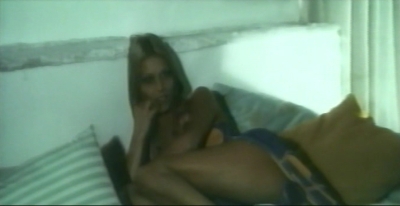
Janet Agren in Tecnica di un amore
Tecnica di un amore was initially rejected by the censorship commission with the motivation that “the film is based around an obsessive eroticism and the dialogue and certain sequences […] are described with such a raw sexual realism that they offend the common sense of morality.” It later passed in appeal with several cuts. Starting with its enigmatic, almost self-mocking title (which translates as Technique of a Love), Tecnica di un amore seems like a bitter endnote to Antonioni’s cinema of alienation: sparse characters and plot, somnolent pacing, tormented dialogues. Again, sex is a tool of power and manipulation, and Monika – a cold, emotionless figure which somehow recalls Terence Stamp’s enigmatic character in Pasolini’s Teorema – is a dark angel of destruction, appearing out of nowhere to destroy the feeble and illusory house of cards that is Andrea and Sabina’s marriage. All this is topped by a sense of loss, as if it’s too late to go back and recover one’s mistakes and bad choices. Andrea’s character – a frustrated intellectual who sold out to Power – displays autobiographical traits, while the final explosion of violence, with Agren and Botti falling to death in slow-motion, is as unexpected as it is desperate, displaying Rondi’s disillusion toward the era of sexual liberation and its effects on Italian bourgeoisie. His following output was even more raw and pessimistic.
Ingrid sulla strada (1973) tells the story of a Finnish girl (Janet Agren) who, after being raped by her drunk father, moves to Rome to be a prostitute. There, she befriends a generous whore (Francesca Romana Coluzzi) whose lover Renato (Franco Citti) is the head of a neofascist squad. Rondi’s description of the prostitution underworld is often grotesque (Enrico Maria Salerno pops up as a necrophile aristocrat, in a scene loosely inspired by Buñuel’s Belle de jour), and he lets comedy and tragedy clash with uneasy results. It almost looks as if the director wanted once again to go back to La dolce vita: the Rome we get to see in Ingrid sulla strada is a wild mess, filled with disillusioned artists, perverted noblemen, neonazis and bombings. It’s a hysterical and cruel city, a Babel about to collapse, “a city full of nothingness” as Salerno says. Audiences were probably bewildered: the film was too vulgar and violent for intellectuals, yet too intellectual for those who paid their ticket to watch a skin flick. Like Valeria, Ingrid’s neurotic behaviour is caused by a sexual childhood trauma. She alludes she can dominate males by having them pay for her body, but she ends up being exploited and badly humiliated, so that suicide looks like the only option.
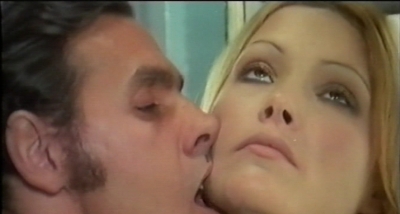
A disinterested Ingrid (Janet Agren)
In the film’s most shocking scene, Renato tortures a band member (Luciano Rossi) who has betrayed him. He forces him to eat a bowl of excrements, mocks him (“It’s first quality shit, just what should be offered to spies and traitors like you. This evening there’s nothing else on the menu, isn’t it, maître?”), extinguishes a cigarette on the man’s tongue (“After a good meal, a cigarette’s just what you need!”). Then he cuts off his tongue with a razor. This almost unbearable sequence predates a similar moment in Pasolini’s Salò, where Paolo Bonacelli has a girl eat feces and a boy has his tongue cut off. As Alberto Pezzotta noted, “It’s likely Pasolini had seen the film (or that Citti mentioned it to him) and that perhaps he recalled it when shooting Salò. Which adds a different perspective (of widespread violence in the criminal subproletarian Roman underworld) on Salò??’s final tortures.” [21] Furthermore, Ingrid is gang-raped by Renato and his men, and the violence is filmed by another band member, just like the torturers did in ??Salò??’s final scene. Rondi even throws in a grim in-joke, as Renato instructs the operator: “Do many close ups, and don’t use the zoom – that’s amateurish!”. Given the predominance of zooms in Italian cinema of the period, it looks as if Rondi is bitterly mocking his own auteur status: what he is shooting may be bad, but at least he is aware of it. Had Rondi put more control in his own script and direction, ??Ingrid sulla strada could have been a minor masterpiece. Even though flawed, it still is an interesting film: unfortunately it was soon forgotten and never released on homevideo. Adding insult to injury, in France it was spiced with crude hardcore inserts.
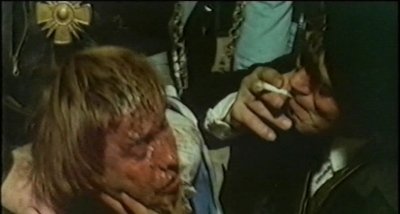
The same destiny awaited Rondi’s next film, Prigione di donne (1974), whose French versions featured hardcore inserts. Rondi’s take on the “women in prison” genre benefitted from a more drastically political script, helmed with the cooperation of criminologist Aldo Semerari (who had worked as medical advisor on Valeria dentro e fuori), and paid homage to Renato Castellani’s Nella città l’inferno (1958) with the character of the prostitute (Marilù Tolo), modelled on that of Anna Magnani in Castellani’s film. The story of an innocent French girl (Martine Brochard) arrested in a drug bust allows Rondi to show the shortcomings of the Italian justice system, seen as an instrument of institutional repression of lower class’ instances, with the cooperation of the Church: the prison is led by an elderly, grotesque Mother Superior – Maria Cumani Quasimodo, former wife of Nobel prize winner poet Salvatore Quasimodo – who has the inmates pray at dinner in exchange for a glass of vermouth (similarly, in Valeria dentro e fuori the nuns brought desserts to quell a rebellion of the patients at dinner). Yet Rondi doesn’t shy away from the required amount of naked flesh, masturbations, lesbian relationships, showers, and Prigione di donne is among his less convincing works as a whole.
Another unfilmed project whose final draft is dated late 1974 is L’età della ragione (The Age of Reason), written with Suso Cecchi D’Amico. Rondi thought of it as “the story of a journey which is also the story of a spiritual epiphany,” set in Ceylon and inspired by his journeys in the Far East. An estranged English/Italian couple, Peter and Luciana, travel to Ceylon to find Luciana’s younger brother Robby, who has disappeared. They find him in an hospital after a drug overdose, but it turns out Robby left London not only to pursue Oriental religions, but also to break up his secret liaison with Peter. When Luciana discovers the truth she runs away and ends up following a Buddhist monk in a pilgrimage in the forest. Peter and Robby eventually find her, but – in a delirious ending which features a ??Soldier Blue??-style massacre perpetrated by the army on Cingalese civilians – Robby sets himself on fire like a bonzo. Peter and Luciana bury his ashes by a statue of Buddha and leave together. Even though Rondi was obviously fascinated with Buddhist rituals and planned to shoot on location, the script sounds like a confused potboiler, and the homosexual angle is rather awkwardly explored.
Rondi’s next film, I prosseneti (1976), was a decidedly more personal and focused work, starting with the title – a juridical term for “panders”. Once again Rondi chose a strictly defined environment: the action takes place almost entirely in a luxurious villa outside Rome whose owners, Count Davide (Alain Cuny) and his wife Gilda (Juliette Mayniel) manage a racket of high-class prostitutes for wealthy clients: a sadistic mercenary re-enacts the torture of a helpless victim (Stefania Casini); a stage director (played by director Luciano Salce in one of the film’s funniest scenes) sets up an elaborate staging inspired by Joseph Conrad’s novels, turning the villa’s garden into a tropical island and having the prostitute (Silvia Dionisio) play a native; an ambassador (José Quaglio) has a girl (Ilona Staller) act as the man’s old estranged flame.
The mocking, surreal tone – such as Cuny’s monologue on an exercise bike – recalls Buñuel at times, and once again Rondi’s target is Italian bourgeoisie, while the film’s theme is prevarication (sexual, economical, physical and mental). Lower classes are exploited and corrupted, as shown by the episode of a young naive Southern girl, Linda (Consuelo Ferrara), who is brought to the villa, drugged and forced to serve a client’s desires. The morning after, as she cries in shame and despair, she is coldly given her pay for the day and told that she can either leave or stay in the villa as one of the Counts’ “girls”. Moreover, youth and beauty are exploited and vampirized by the old. “The most expected guest – without offending anyone – has arrived: youth itself. The object of all our anxieties, all our regrets. What we have never been… what we will never be,” Cuny announces when an 18 year old girl (Sonja Jeannine) arrives at the party on a motorbike.
The Count and his wife are worthy descendants of Freda’s elderly countess in I vampiri: if Gianna Maria Canale fed on the blood of young women, here Sonja Jeannine is groped by a bunch of slimy elderly guests who verse champagne and cream on her naked body, as if they want to consume and devour the very essence of her youth. It’s a moment that harks back to the final orgy in La dolce vita, but also recalls the chilling feast that ends Francesco Barilli’s The Perfume of the Lady in Black. “Do you want my eighteen years? I open my veins and I offer you my blood. I will be your food, eating me you will bring a bit of my youth in you… eat me, drink me, kill me if you like, but do it quickly though because I’m leaving in half an hour!” Jeannine says. As Pasolini stated in Salò, victims are now the accomplices of their torturers, and the film ends with Linda coming back to the villa, now fully aware of her role and hopelessly corrupted.
At the time, few critics noticed Rondi’s discourse, and hastily dismissed the film as pretentious and exploitative, and I prosseneti didn’t perform well at the box office either. However, Rondi’s discourse is today clearer and stronger than ever. As with Ingrid sulla strada, cinema is shown as a medium of power, in a scene featuring an 8mm film juxtaposed to a sexual encounter. And sex itself has become a pantomime, a play (explicitly so in the Salce episode), with all the passion and the joy replaced by a rigid set of rules and roles. As an Italian critic notes in a recent analysis of the film, Rondi’s vision predates “a reality based solely on the image, where woman becomes a bribe and replaces money as an instrument of corruption; meanwhile, finance and sex are tied in an unlikely embrace, giving rise to a plutocratic system where the old feeds with the young.” [22] That is to say, Italy NOW.
No wonder Rondi’s next film was another work for hire, starting with the presence of sexy stars Laura Gemser and Annie Belle in the leading roles. Originally entitled Il gruppo – Le radici del male (The Group – Roots of Evil) and based on a story by Ferdinando Baldi, Velluto nero (1976) is a crepuscular variation on the “Black Emanuelle” cycle, with its exotic settings and eroticism: it was released abroad as Emanuelle In Egypt and Black Emmanuelle??/ ??White Emmanuelle (another export title, Smooth Velvet, Raw Silk, was at least more similar to the Italian one, which translates as Black Velvet). Nowadays it’s Rondi’s only film available on dvd in English language (in a gorgeous U.S. Severin edition).
Velluto nero is populated by bizarre, decadent characters (Feodor Chaliapin, jr. pops up as a decadent homosexual silent movie star who quotes Spanish Golden Age Calderón dela Barca’s play Life is a Dream, 1629-1635) and at times it looks like Rondi is trying to say something about the state of Italian cinema and Italy in general. In one scene, Gemser poses near the putrefying carcass of a dog while her lover, a fashion photographer (Gabriele Tinti) frantically shoots pictures of her: “Make it look like you’re in bed with him, get it?”, he yells. Later on Tinti has her pose near dead bodies, and in another scene he says: “The camera is my eyes, my nose, my penis!” [23]
It’s likely Rondi’s view on the mondo-movie genre hides a sarcastic reference to Mondo Cane??’s director Gualtiero Jacopetti (who had once cruelly mocked ??La dolce vita). On the other hand, it’s a disenchanted meditation on the road to excess that characterizes Italian cinema of the period. “It makes you happier to be alive. Disgust is edifying!” Tinti says. However, Rondi does not step back from competition: the group of wealthy people who gathered far away from the Western world spend their time copulating with each other and with the natives, and the director asks a lot to his lead actresses: in one scene, after a simulated fellatio performed by Susan Scott on Al Cliver, we get to see sperm on the actress’ face, something quite daring for a softcore film. That’s not enough to make it a good film, yet with its plumbeous yet sensual atmosphere, to Rondi Velluto nero is both a way to show his “cupio dissolvi” and an extreme act of resistance to the imminent homologation, which will be both aesthetic and ideological.
After Velluto nero, Rondi remained six years without shooting, even though he produced a number of unfilmed scripts. Love Song, dated 1976, was another exotic/erotic flick, featuring a theatre director, Giuliano, who goes to Phuket, Thailand with his crew to stage Bertolt Brecht’s play The Caucasian Chalk Circle. The first half amply details Giuliano’s sexual relationships with his four main actresses, while the arrival of the director’s estranged wife turns the second half into a more intimate meditation on the loss of desire between a married couple. The character of Giuliano, a tormented intellectual obsessed with sex, is a compendium of motives seen in Rondi’s previous films, and the description of the protagonist’s conjugal crisis sounded sincere, yet the script seems like a late riff on Ugo Liberatore’s tropical exotic dramas on midlife crisis such as Bora Bora (1968).
Rondi directed his last film in 1982. La voce was a biography of young Mother Teresa of Calcutta featuring Bekim Fehmiu and Rossano Brazzi in small roles. The film tells episodes in the life of seventeen-old Gongia (Liliana Tari) in 1920s Albany that lead her to the decision of becoming a nun under the name of suor (sister) Teresa (although the film never mentions it: that’s probably why an alternative title was La vocazione di suor Teresa). Despite a script signed by Rondi and Tullio Pinelli, a passable period recreation and a good performance by Tari, it’s a flat and rather dull biopic: Rondi managed to avoid apologetic tones, but the story has little appeal and weird directorial choices, such as musical numbers showing Gongia’s passion for singing. Rossano Brazzi has a cameo as an elderly monk.
La voce was barely released in theaters and shown on TV in early 1983, before disappearing into obscurity. Rondi himself stepped back into silence, watching Italian cinema tumble down and witnessing the triumph of commercial television. In one of his latest essays, dated 1986, he attacked the “disintegration of viewing, as the mind goes on in shocks, cracks and splits, risking schizophrenia.” [24] His propositions for better TV – giving audiences more culture, art and philosophy, treating them as thinking people and not as lobotomized puppets: Rondi even suggests having a painter paint for the camera as Picasso did in H. G. Clouzot’s Le mystère Picasso – sounds like the words of a saviour speaking against the wind.
Brunello Rondi died in Rome on November 7, 1989, just a couple of months before the release of Federico Fellini’s final film La voce della luna (1990), another desperate cry of help against the cultural and moral agony of a whole country. In the following years, Rondi’s role as Fellini’s collaborator has often been overlooked and underestimated, and his directorial output has been reviled and ignored. As of today, most of his films are unreleased in homevideo and are only marginally available in badly cut copies. Yet he was a vital intellectual spirit, who chose to portray his country and the times he lived in not, as Zavattini hoped he would, with the tenderness of a man who recounts his first love, but with the embittered disillusion of a betrayed lover. As the most illuminated mind of his generation, he could foresee what was coming next. Over forty years later, the words he wrote for Romolo Valli in a scene of Scacco alla regina are still a chilling epitaph, more actual than ever. “Most people are afraid of freedom, they just don’t want it. Freedom means responsibility, it means risk. People don’t want to risk – they want security.”
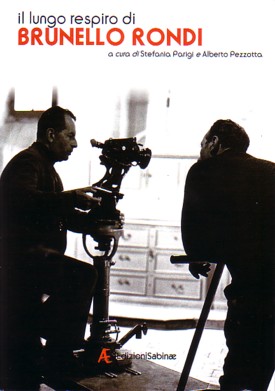
Book on Rondi. ed Stefania Parigi, Alberto Pezzotta. With author Curti contribution
FILMOGRAPHY
Collaborations (note: screenplay credits are shared unless noted)
Ultimo amore (1957, d.: Luigi Chiarini) screenplay, assistant director
Francesco giullare di Dio (1950, Roberto Rossellini) screenplay, assistant director
Altri tempi – Zibaldone n. 1 (1952, Alessandro Blasetti) screenplay
Europa ’51 (1952, Roberto Rossellini) screenplay
Sua Altezza ha detto: no! (1953, Maria Basaglia) assistant director
La strada (1954, Federico Fellini) artistic advisor
Il bidone (1955, Federico Fellini) assistant director
L’ultimo amante (1955, Mario Mattoli) assistant director
Le notti di Cabiria (1957, Federico Fellini) artistic advisor (and contributing writer, uncredited)
La dolce vita (1960, Federico Fellini) story, screenplay, artistic advisor
Era notte a Roma (1960, Roberto Rossellini) screenplay
Le tentazioni del dottor Antonio (Boccaccio ‘70) (1962, Federico Fellini) contributing writer, assistant director
8 ½ (1963, Federico Fellini) screenplay, artistic advisor
Le ore dell’amore (1963, Luciano Salce) actor
Giulietta degli spiriti (1965, Federico Fellini) screenplay
Arabella (1967, Mauro Bolognini) story
Amanti (1968, Vittorio De Sica) screenplay from his own theatre play
Le sorelle (1969, Roberto Malenotti) screenplay
Scacco alla regina (1969, Pasquale Festa Campanile) screenplay
Fellini-Satyricon (1969, Federico Fellini) contributing writer
Prova d’orchestra (1978, Federico Fellini) contributing writer
La città delle donne (1980, Federico Fellini) contributing writer
Ginger e Fred (1986, Federico Fellini) contributing writer (uncredited)
As director/screenwriter
Una vita violenta (1962: co-d.: Paolo Heusch) also screenplay (w/Paolo Heusch, Franco Solinas)
Il demonio (1963) also story and screenplay (w/Ugo Guerra, Luciano Martino)
Più tardi Claire, più tardi… (1965-66) also screenplay (w/Giuseppe Mangione, Vittoriano Petrilli)
Domani non siamo più qui (1967) also story and screenplay
Le tue mani sul mio corpo (1970) also screenplay (w/Francesco Scardamaglia)
Valeria dentro e fuori (1972) also screenplay (wAldo Semerari)
Racconti proibiti… di niente vestiti (1972) also screenplay (w/Roberto Leoni, Gianfranco Bucceri)
Tecnica di un amore (1973) also screenplay (w/Piero Regnoli)
Ingrid sulla strada (1973) also story and screenplay
Prigione di donne (1974) also story and screenplay (w/Leila Buongiorno, Aldo Semerari)
I prosseneti (1976) also story and screenplay
Velluto nero (1976) also screenplay
La voce (1982) also story and screenplay (w/Tullio Pinelli)
This essay, published on Dec. 31, 2011, was slightly revised, on the request of Rondi’s son, on September 24, 2016.
Endnotes
1 Cesare Zavattini, Diario, Cinema nuovo, n.126, March 1958, p. 136-137.
2 Anonymous, Corriere della Sera, May 17, 1973.
3 Federico Fellini, Intervista sul cinema (edited by Giovanni Grazzini), Laterza 1983-2004, pp. 126-127
4 “I thought ancient history could be brought to the screen with enormous zest for life, a wonderful sunny and playful attitude which Fellini clearly repudiated. […] So that is why, despite having a very important contract with [producer] Alberto Grimaldi to sign the screenplay at par with others, I asked that my name appeared simply as a contributor to the subject…” Brunello Rondi, in Franca Faldini, Goffredo Fofi (edited by), Il cinema italiano d’oggi 1970-1984 raccontato dai suoi protagonisti, Mondadori, Milano 1984, p.
5 According to Rondi’s son Umberto, he also contributed (uncredited) to Fellini’s Ginger e Fred (1986).
6 Alberto Pezzotta, Introduction to “Una vita violenta, essay included in the booklet of the Italian dvd release of the film (Minerva Classic).
7 Raymond Durgnat, Sexual Alienation in the Cinema, Studio Vista, London 1972, p. 163.
8 Brunello Rondi, Come, perché ho girato “Il demonio”, Filmcritica n. 143-144, marzo-aprile 1964.
9 It’s still missing from the Italian dvd (Medusa Home Video) which restores other cuts.
10 Edoardo Bruno, Realtà e surrealtà ne Il demonio di Rondi, «Filmcritica» n. 145, May 1964.
11 Durgnat, Sexual Alienation in the Cinema, p. 164.
12 Franca Faldini, Goffredo Fofi, L’avventurosa storia del cinema italiano raccontata dai suoi protagonisti 1960-1969, Feltrinelli, Milano 1981.
13 The script is kept at the CSC library in Rome.
14 Alberto Ceretto, “Rivive l’Apocalisse nel nuovo film di Rondi,”Corriere della Sera, January 22, 1967.
15 “Una luna di miele che nasconde un delitto,” Corriere della Sera, October 10, 1967.
16 Another unreleased film Rondi worked on was Sortilegio (1969-70?), directed by Nardo Bonomi and starring Erna Schurer and Marco Ferreri, a strange, unclassifiable film partially inspired by the work of Aleister Crowley about a woman driven to suicide by her husband with the help of a mysterious cult. The film showed Rondi’s interest in the occult and esotericism, which would feature prominently in Tecnica di un amore (1973).
17 Alberto Ceretto, “Con l’occhio del cinema nei tormenti di una donna,” Corriere della Sera, February 22, 1972.
18 D.g., “Un viaggio alla scoperta della donna,” L’Unità, June 1,1972.
19 Leoni and Bucceri co-wrote Tonino Valerii’s masterful giallo My Dear Killer (1972).
20 Andrea Pergolari, La fabbrica del riso. 32 sceneggiatori raccontano la storia del cinema italiano, Unmondoaparte, Roma 2005, pp. 238-239.
21 Alberto Pezzotta, “Alla scoperta dell’autore impari,” Segnocinema n. 110, luglio-agosto 2001, p. 7.
22 Fabrizio Fogliato, “Brunello Rondi parte 9 – “I prosseneti”.
23 Original Italian dialogue. As can be noticed comparing the Italian and English audio track on the Severin DVD, the latter is quite different. Even several characters names have been changed in the dubbing: Laura Gemser (Emanuelle in the Italian audio track) become Laura, Annie Belle (Laure) becomes Pia, Al Cliver (Antonio) becomes Orazio.
24 Brunello Rondi, “Tv, cbe fare?” Il Messaggero, August 18, 1986.



